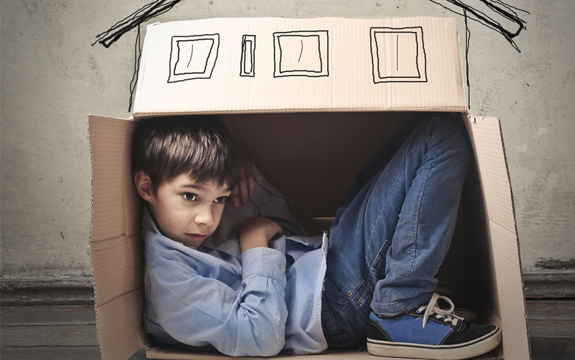Rental housing policies trap children in poverty

In Summary
- Analysis for The Conversation by Associate Professor Wendy Stone and Margaret Reynolds, Swinburne University of Technology
This year Australians have been shocked by the evidence about the risks to children in some out-of-home care settings.
We also learned that women and children comprise a large proportion of Australia’s homeless population. What we know far less about is how some of Australia’s most vulnerable children fare in what our analysis shows is the fastest-growing part of our mainstream housing system: private rental.
In research released today (see the report here or a summary here), researchers at Swinburne University shed light on this question. The study is one of the first of its type in Australia to enumerate children and young people’s housing disadvantage.
With home ownership rates falling and social housing in short supply, the private rental sector now houses one in four households and one in three Australians. We calculate that, in 2013-14, this included 1,037,802 families with dependent children and young people. So, what kind of childhood does private rental – and the policy settings that shape it – provide?
The Australian Bureau of Statistics’ Survey of Income and Housing and Census of Population and Housing are used to examine children and young people’s exposure to affordability stress, using a rent-to-income ratio. This shows the proportion of income (adjusted for family size) that lower-income families with dependent children spend on rent. The study focused on children in the very lowest-income families (lowest 20%) and next-lowest (second-lowest quintile).
So what did the study find?
The findings are bleak. In 2013-14, 46% of these low-income couple families and 67% of one-parent families with dependent children in private rental housing paid more than 30% of their income on rent – the point above which it is considered difficult to make ends meet.
Using a child-focused method to establish how many children are exposed to unaffordable private rental housing in 2003-4 and 2013-14, the study shows:
- 183,500 children (0–14 years old) in low-income (bottom 40%) couple-headed families in private rental dwellings live with housing affordability stress. This is an increase of five percentage points since 2003-04 (42%).
- 158,300 children (0-14) in low-income (bottom 40%) one-parent families in private rental dwellings are in housing affordability stress (67%).

Rises in proportions of low-income families (bottom 40% of incomes) with children aged 0-14 that are paying unaffordable rent. Original analysis ABS Survey of Income and Housing, 2003-04, 2013-14, Author provided
Risk factors for childhood exposure to rental affordability stress include: living in a low or very low-income family; living in a single-parent low-income family; being a young child (0-14, rather than 15-18) in a low-income family; and living with a low-income parent born overseas.
Using Victoria to illustrate the spatial risks, we find that living in regional areas provides some rent relief, but not as much as it used to. Findings show:
-
only one in ten children aged 0–14 in lowest-income families (bottom 20%) in metropolitan Melbourne are living with affordable rent levels, so nine in ten are not (91%); and
-
three in ten children aged 0–14 in lowest-income families (bottom 20%) in regional Victoria are living with affordable rent levels, so seven in ten are not (69%).

Percentages of children living in low-income households paying unaffordable rent across Victoria. ABS Census of Population and Housing, 2006, 2011, Author provided
Related evidence indicates that:
-
private rental conditions represent some of the least secure, affordable and sustainable housing for families with children;
families with children make up 30% of private renters who rent for more than ten years; and
-
precarious housing leads to locational disadvantage.
What can be done about this?
While many families are struggling privately to navigate the effects of unaffordable housing while raising their children, these findings raise the important question: where does housing governance lie?
Current housing policy settings are not working for children, young people and their families. The almost-but-not-quite changes at the 2016 election to target negative gearing – in order to increase the affordable housing supply via tax reform – might have brought some relief to the lowest-income families in the rental sector. But what of the conditions of short-term leasing and run-away rents?
A wide-ranging review of tenancy legislation in Victoria is underway. This offers some hope of reforms that will assist children and young people in our mainstream housing system. Secure leasing, rent increases and housing quality are under review.
In New South Wales and some other states, moves are also afoot to improve housing conditions for tenants.
The findings of our new research suggest these reforms are necessary but not sufficient to alleviate childhood exposure to rent-related poverty.
Our findings also point to the need to:
- revisit negative-gearing reform
- evaluate the effectiveness of Commonwealth Rent Assistance;
- provide adequate income support for families; and
- potentially reinvest in innovative forms of socially supported housing fit for families’ 21st-century housing needs.
Ultimately, the increasing proportions of Australia’s children living in housing-related poverty must force us all to consider the questions: who is responsible for the problem? And what will we do about it?
![]() Written by Wendy Stone, Associate Professor; Director, Australian Housing and Urban Research Institute, Swinburne University of Technology and Margaret Reynolds, Researcher, Swinburne University of Technology. This article was originally published on The Conversation. Read the original article.
Written by Wendy Stone, Associate Professor; Director, Australian Housing and Urban Research Institute, Swinburne University of Technology and Margaret Reynolds, Researcher, Swinburne University of Technology. This article was originally published on The Conversation. Read the original article.

